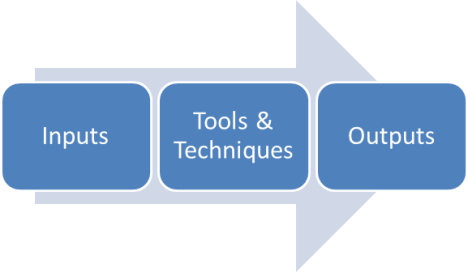This post contains the general description of project management processes to be found at the beginning of chapter 3 of the 5th Edition of the PMBOK® Guide.
1. Project Management vs. Product-Oriented Processes
There are two types of processes, project management processes and product-oriented processes. Project management processes apply globally to all projects; product-oriented processes are specific to each application area. For that reason, since it is meant as a guide for projects in general, PMBOK® Guide only deals with the 47 project management processes.
2. Project Management Processes
A project management process contains tools and techniques which operate on inputs and create as an end result outputs. These outputs often then became inputs of other processes.

3. The 5 Process Groups
The 47 project management processes are divided into five process groups:
|
Process Group |
Characteristics |
| Initiating | Defines a new project or new phase of an existing project to obtain authorization to proceed with the project. |
| Planning | Establishes the scope of the project, defines the objectives, and defines the course of action required to achieve them. |
| Executing | Completes the work defined in the project management plan to satisfy the project specifications. |
| Monitoring & Controlling | Tracks, reviews, regulates progress and performance of project; identifies any potential changes to the plan and then initiates them. |
| Closing | Finalizes all activities to formally close project or phase. |
4. Interaction between Process Groups
When a project is split into phases, the phases are usually sequential, but they can overlap. As oppose to a phase of a project, the five process groups ALL overlap to some extent.
While executing a project, monitoring & controlling is done on a periodic basis to make sure that the project is proceeding according to plan. If it is not proceeding according to plan, then a change to the plan may be required, and so planning may be revised. During the course of executing the project, if you are receiving components from suppliers, you will need to formally close these procurements by accepting them (or suggesting changes if they are not accepted). So the phases can be overlapping AND in some cases parallel.
This also is true for the initiating process group in that it actually involves some high-level planning of the project. Also, major changes suggested during the monitoring & controlling process group may require a look at the charter to see if the project can indeed be completed within its original parameters.
The one word that describes the process group interaction the best is iterative, meaning that there is a back-and-forth movement among them until the project is completed.
The next posts deal in a little more detail with the 5 process groups in order to make you familiar with their function on a project.
Filed under: Uncategorized |


Leave a comment